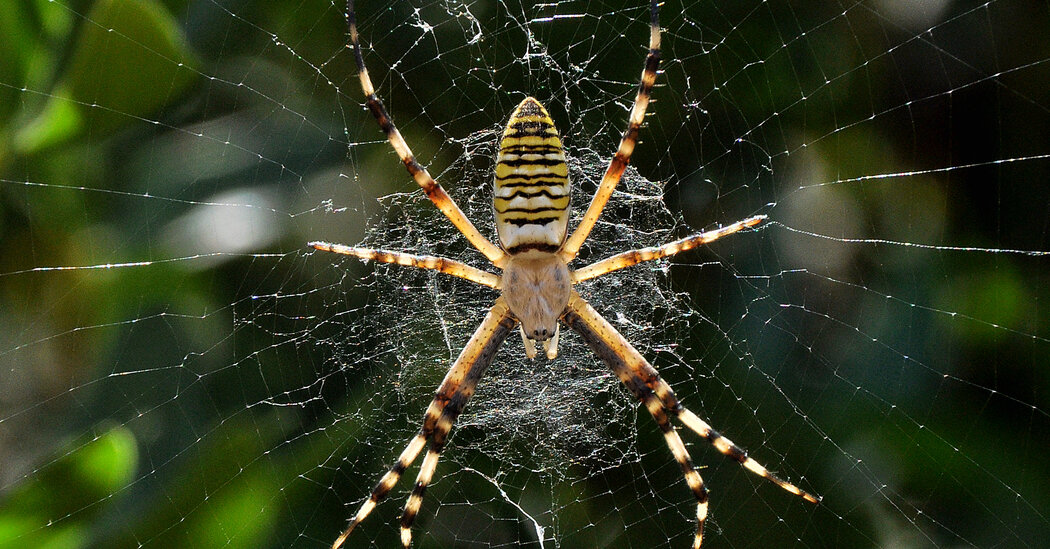After crafting a gauzy web, a spider might reckon that the construction isn’t complete. Some spiders, known as orb weavers, often add decorations, typically spun from silk but sometimes using bits of insect cadavers or shed exoskeleton.
It’s curious that spiders would embellish their webs in this way. The structures seem meant to be light and inconspicuous. Yet spiders add these big, noticeable features, known as stabilimenta, some looking like zigzags, others like a disk that’s been scribbled in thread, or even a big “X” that marks the web’s center.
A study published on Wednesday in the journal PLOS One offers a new explanation for why spiders spin stabilimenta, although it may not resolve the scientific conflict over the subject. It is an area that scientists seem to relish fighting over, said Gabriele Greco, a physicist at the Swedish University of Agricultural Sciences and an author of the study.
“And I was stupid enough to start this topic,” he added.
There’s ample support for the idea that stabilimenta distract birds or wasps that prey on spiders. Spiders are known for vibrating their webs, blurring the stabilimenta, and then scuttling through a hole in the disk or jumping away to safety. But researchers have also hypothesized that the web accessories collect water, or fool insects by reflecting UV light.
Dr. Greco was surprised to learn that there wasn’t much scientific investigation into how stabilimenta affected the structure, motion and vibration of webs. He and his colleagues set out to study the webs of wasp spiders on the Italian island of Sardinia.
One study co-author, Luigi Lenzini, an Italian naturalist, spent two years documenting the species’ stabilimenta. About 50 percent of the wasp spider webs had the decorations. Sometimes threads traced zigzags between two spokes. Other times they formed a platform of matted fibers concentrated in the web’s middle.
Spiders can detect snagged prey through vibrations coursing along the webs’ threads. And they can adjust the tension of a silk thread, altering how vibrations travel. Dr. Greco’s team figured stabilimenta could also affect the speed and distance of such signals.
To test that idea, they used a computer program to simulate webs with and without stabilimenta. At first, they didn’t observe much influence from the decorations on how vibrations traveled.
“We thought that we would have found something much more evident,” Dr. Greco said.
Then a researcher reviewing the study for publication suggested the team try modeling vibrations that kicked off at a tangent to the spiral threads.
In this case, with a stabilimentum that looks like a blobby mass at the web’s center, the models suggested that some vibrations that would otherwise be lost could travel to the other side of the web where the spider could detect them. That central mass may improve the connectivity of the web.
This work brings an old idea about stabilimenta — that they affect the stability and other properties of a web — into the modern era, said Todd Blackledge, a biologist at the University of Akron. But, he said, it’s not clear how much these sorts of simulations, and the assumptions needed to create them, capture the actual behavior of webs. For instance, the modeled webs were circular. But real webs tend to be asymmetric and elongated at the bottom.
And the researchers have yet to test how the effect they found would play out in real webs, added Fritz Vollrath, an evolutionary biologist the University of Oxford who wasn’t part of the work.
“The paradox of the stabilimenta has not been resolved,” he said.
The study’s authors say they are working on setting up experiments to go into the field, prod webs and measure the vibrations.
While the work may not settle any arguments, it could offer some useful technological spinoffs. In some cases, the team found that vibrations traversed webs a few milliseconds faster with decorations than without them. Those milliseconds might not help spiders capture prey, but they could inspire designs for more effective vibration and pressure sensors.
“The implications might actually be more important for materials research, sensor technology than they are for the real animals,” Dr. Blackledge said.
The post Why Spiders Are the Ultimate Interior Decorators appeared first on New York Times.




